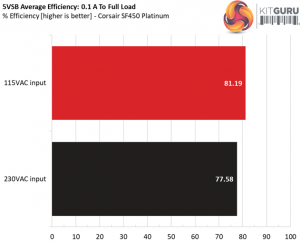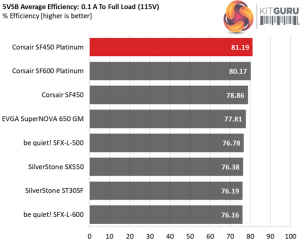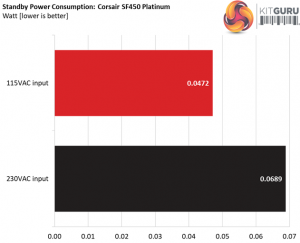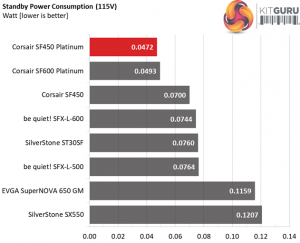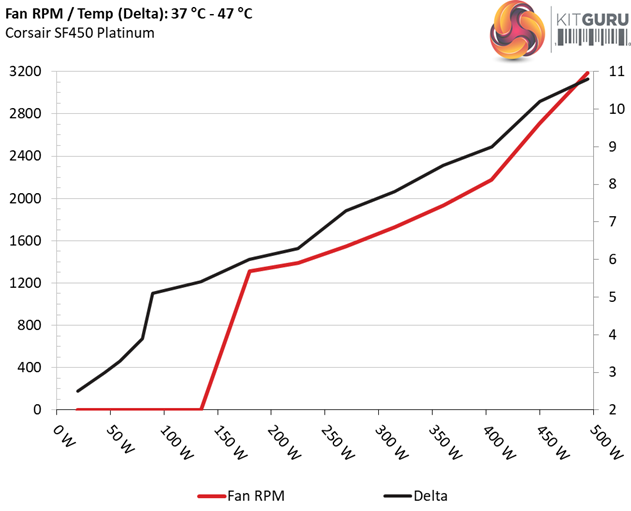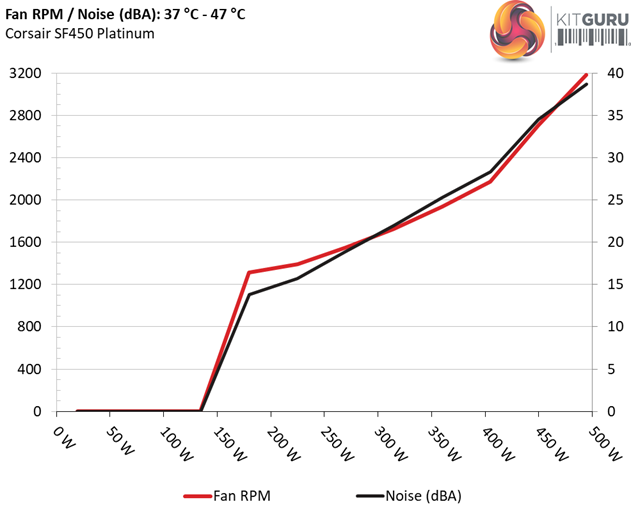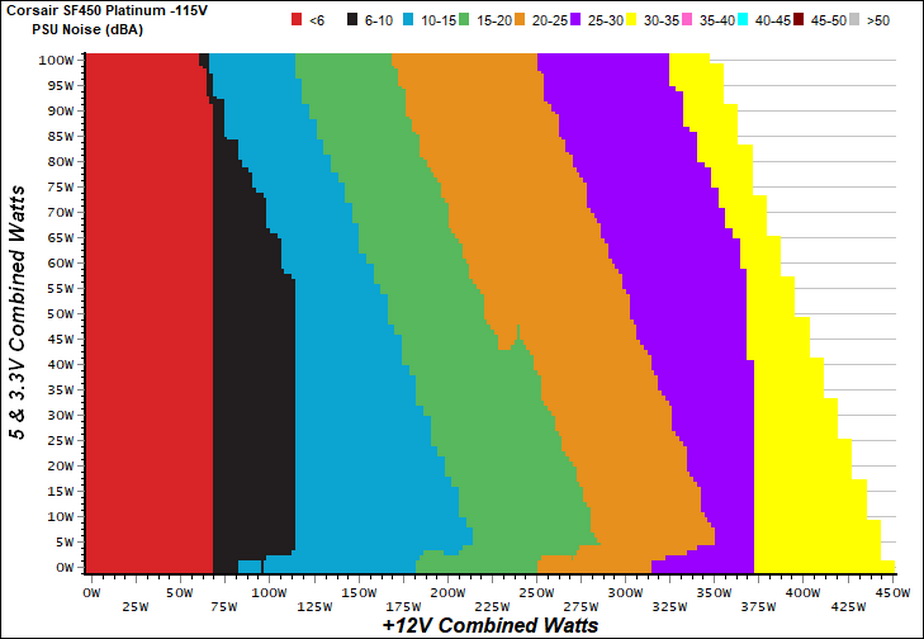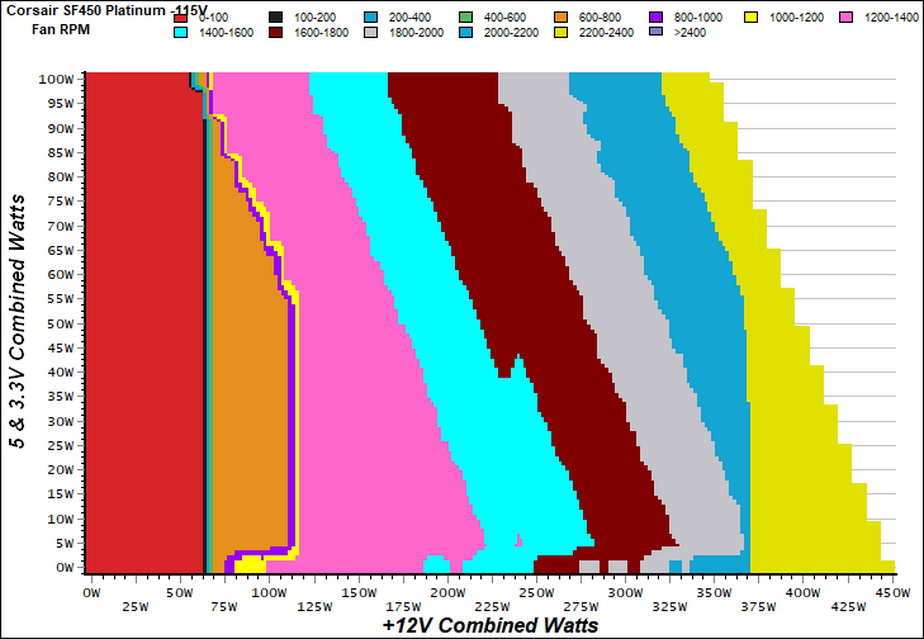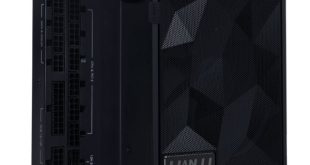Efficiency
Our efficiency testing procedure is detailed here.
Using results from the previous page, we plotted a chart showing the SF450’s efficiency at low loads, and loads from 10 to 110 percent of its maximum-rated capacity.
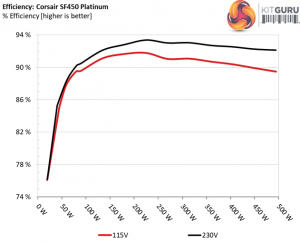
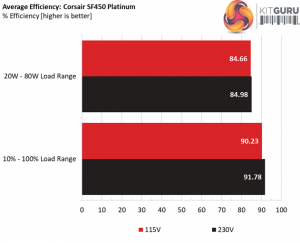
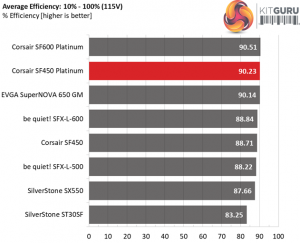
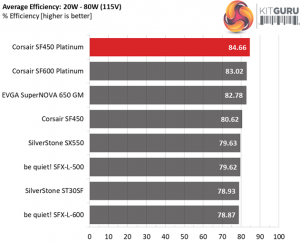
Under normal loads the SF450 Platinum loses only to its big brother, the SF600 Platinum, while with light loads it clearly takes the lead.
Efficiency At Low Loads
In the following tests, we measure the SF450's efficiency at loads significantly lower than 10 percent of its maximum capacity (the lowest load the 80 PLUS standard measures). The loads we dial are 20, 40, 60, and 80W. This is important for representing when a PC is idle, with power-saving features turned on.
| Test # | 12V | 5V | 3.3V | 5VSB | DC/AC (Watts) | Efficiency | Fan Speed (RPM) | PSU Noise (dB[A]) | PF/AC Volts |
| 1 | 1.198A | 0.495A | 0.478A | 0.199A | 19.568 | 76.102% | 0 | <6.0 | 0.791 |
| 12.074V | 5.052V | 3.350V | 5.039V | 25.713 | 115.05V | ||||
| 2 | 2.458A | 0.991A | 0.983A | 0.397A | 39.977 | 85.137% | 0 | <6.0 | 0.858 |
| 12.075V | 5.051V | 3.350V | 5.035V | 46.956 | 115.05V | ||||
| 3 | 3.649A | 1.486A | 1.461A | 5.031A | 59.458 | 87.884% | 0 | <6.0 | 0.899 |
| 12.075V | 5.051V | 3.349V | 5.031V | 67.655 | 115.05V | ||||
| 4 | 4.907A | 1.981A | 1.970A | 0.796A | 79.867 | 89.501% | 0 | <6.0 | 0.930 |
| 12.077V | 5.051V | 3.349V | 5.027V | 89.236 | 115.05V |
This platforms efficiency under light loads is nothing less but impressive! Moreover, the fan doesn't spin at all during those tests so the output noise is minimal.
5VSB Efficiency
The ATX specification (revision 1.4), along with CEC, ErP Lot 3 2014 and ErP Lot 6 2010/2013, states that the 5VSB standby supply efficiency should be as high as possible, recommending 75 percent or higher with 550mA, 1A, and 1.5A of load.
The supply should also achieve higher than 75% efficiency at 5VSB under full load, or with 3A if its max current output on this rail is higher than 3A.
We take six measurements: one each at 100, 250, 550, 1000, and 1500mA, and one with the full load the 5VSB rail can handle.
| Test # | 5VSB | DC/AC (Watts) |
Efficiency | PF/AC Volts |
| 1 | 0.100A | 0.505 | 71.530% | 0.260 |
| 5.042V | 0.706 | 115.05V | ||
| 2 | 0.250A | 1.260 | 83.610% | 0.341 |
| 5.040V | 1.507 | 115.05V | ||
| 3 | 0.550A | 2.771 | 85.288% | 0.401 |
| 5.037V | 3.249 | 115.04V | ||
| 4 | 1.000A | 5.032 | 85.332% | 0.441 |
| 5.031V | 5.897 | 115.05V | ||
| 5 | 1.500A | 7.538 | 83.905% | 0.463 |
| 5.025V | 8.984 | 115.04V | ||
| 6 | 2.500A | 12.532 | 84.300% | 0.489 |
| 5.012V | 14.866 | 115.04V |
Great Wall vastly improved the efficiency of the 5VSB rail. The new SF Platinum models easily beat the competition and they are able to put to shame as well, many high-end ATX offerings. Unfortunately not many manufacturers pay attention to this rail's efficiency, so it is great to see such designs.
Power Consumption In Idle And Standby
In the table below, you’ll find the power consumption and voltage values of all rails (except -12V) when the PSU is idle (powered on, but without any load on its rails), and the power consumption when the unit is in standby mode (without any load, at 5VSB).
| Mode | 12V | 5V | 3.3V | 5VSB | Watts | PF/AC Volts |
| Idle | 12.095V | 5.050V | 3.348V | 5.044V | 5.185 | 0.499 |
| 115.1V | ||||||
| Standby | 0.047 | 0.027 | ||||
| 115.1V | ||||||
The energy needs in idle are kept at very low levels, with both voltage inputs that we apply.
Fan RPM, Delta Temperature, And Output Noise
Our mixed noise testing is described in detail here.
The first chart below illustrates the cooling fan's speed (in RPM), and the delta between input and output temperature. The results were obtained at 37°C (98.6°F) to 47°C (116.6°F) ambient temperature.
The next chart shows the cooling fan's speed (again, in RPM) and output noise. We measure acoustics from one meter away, inside a hemi-anechoic chamber. Background noise inside the chamber is below 6 dB(A) during testing (it's actually much lower, but our sound meter’s microphone hits its floor), and the results are obtained with the PSU operating at 37°C (98.6°F) to 47°C (116.6°F) ambient temperature.
The following graphs illustrate the fan's output noise and speed over the PSU's operating range. The same conditions of the above graph apply to our measurements, though the ambient temperature is between 30°C (86°F) to 32°C (89.6°F).
The semi-passive mode doesn't last long, since we heavily stress the minor rails during those tests and as it seems its operation also takes into account the temperatures of the DC-DC converters, that generate 5V and 3.3V.
It will need close to 375W load to make the power supply enter the 30-35 dB(A) zone, while with up to 250W at +12V the output noise stays below 20 dB(A).
 KitGuru KitGuru.net – Tech News | Hardware News | Hardware Reviews | IOS | Mobile | Gaming | Graphics Cards
KitGuru KitGuru.net – Tech News | Hardware News | Hardware Reviews | IOS | Mobile | Gaming | Graphics Cards


